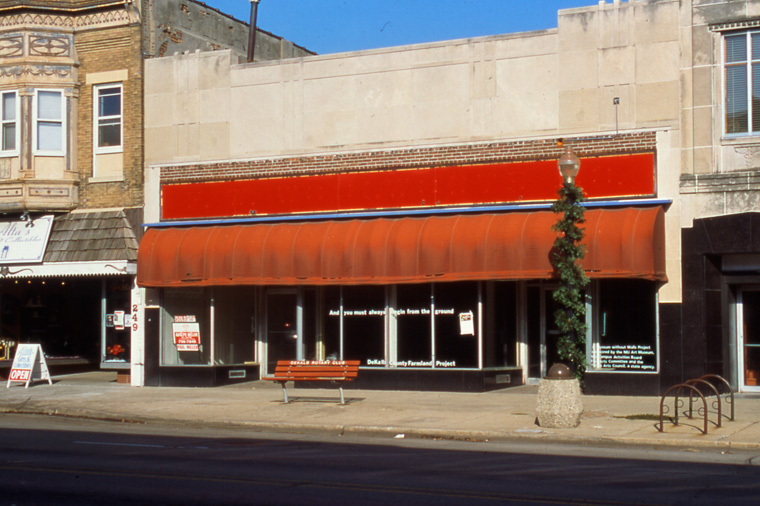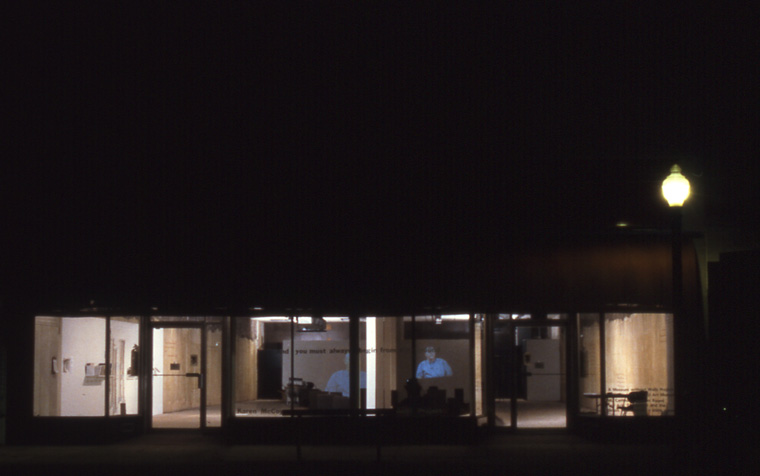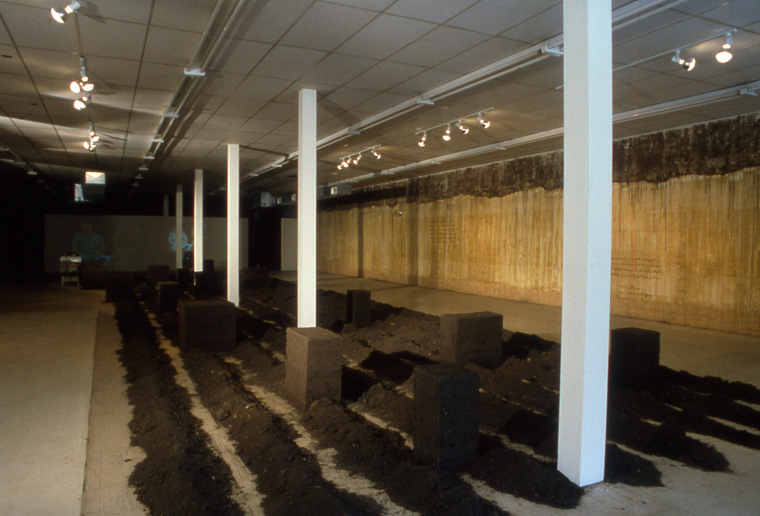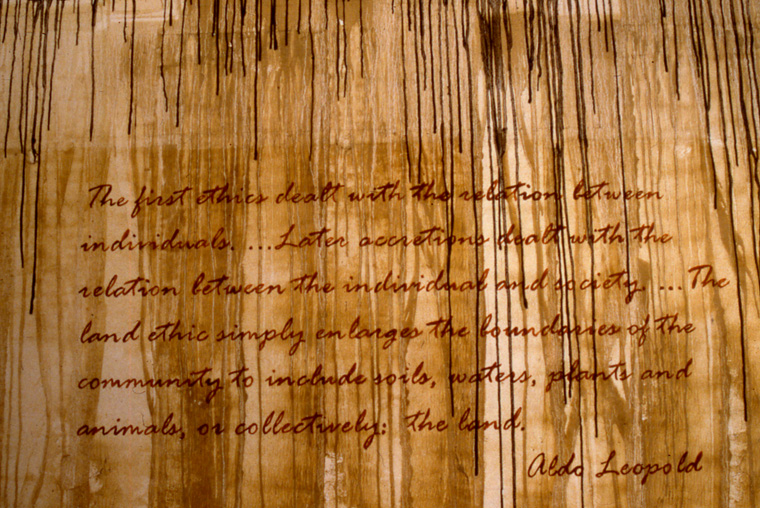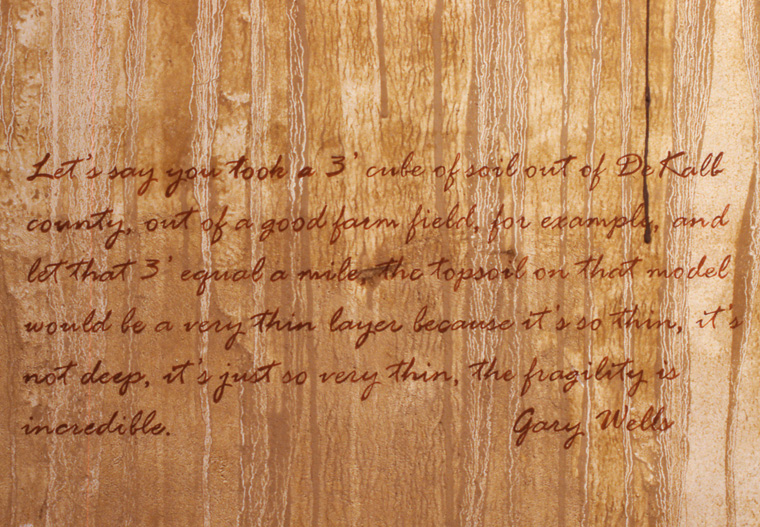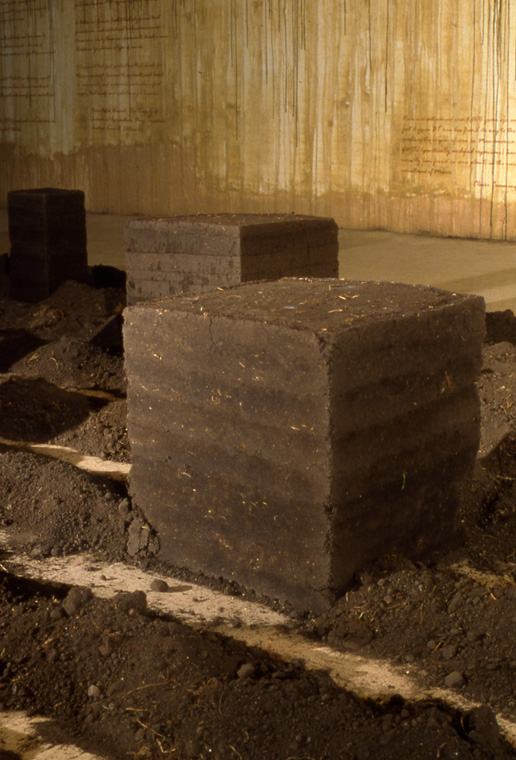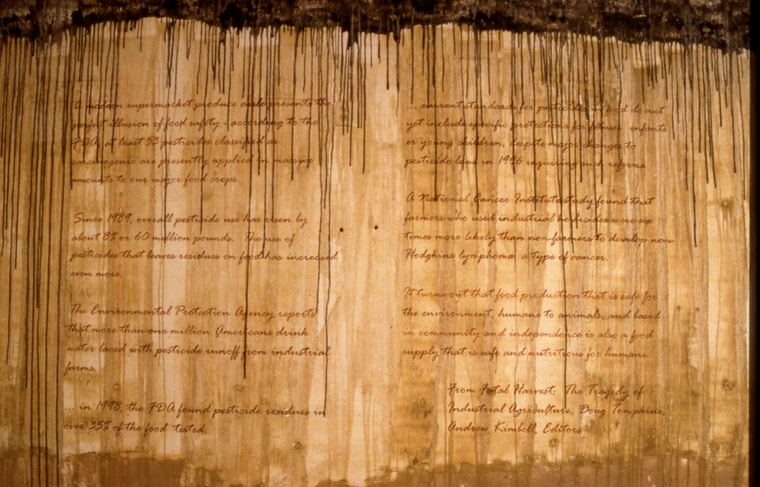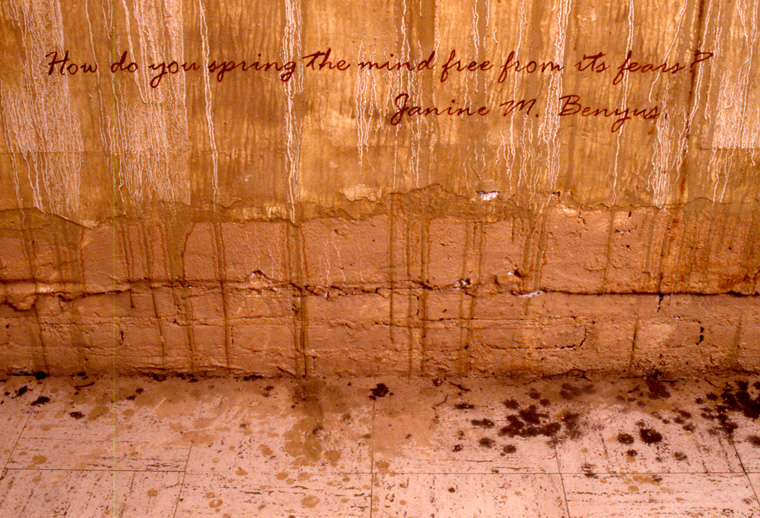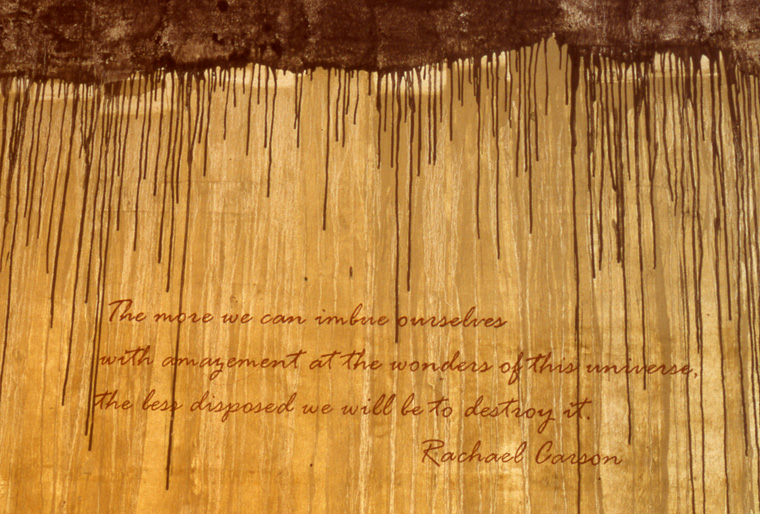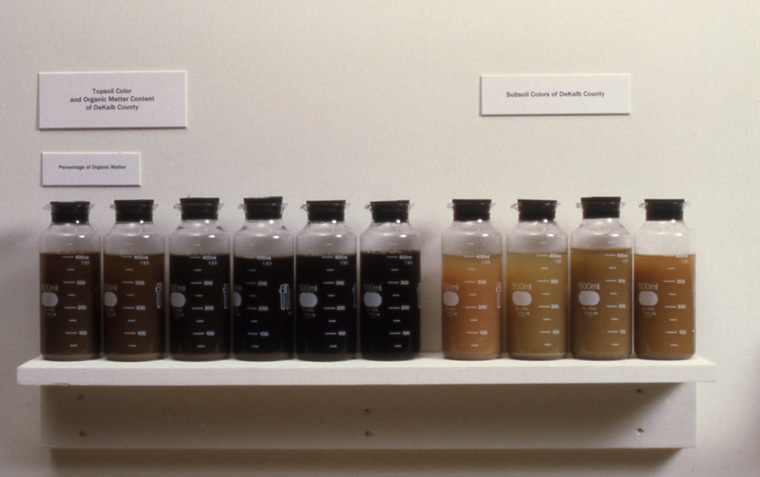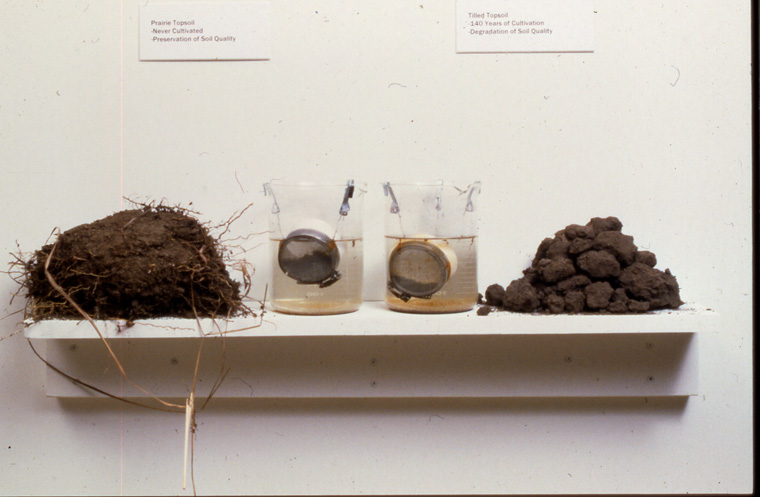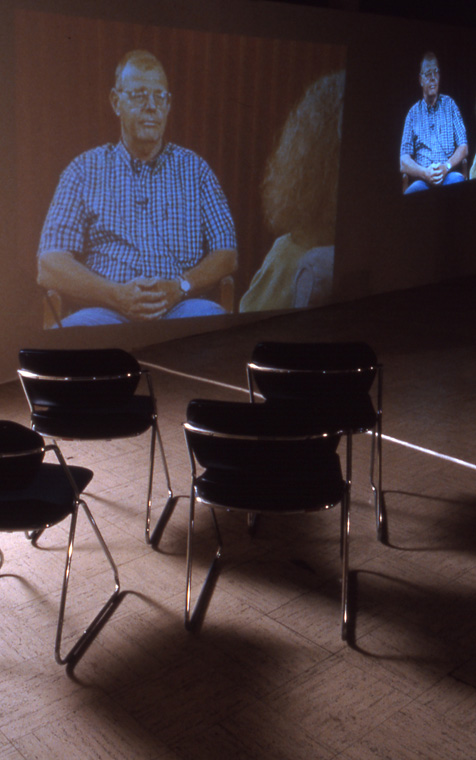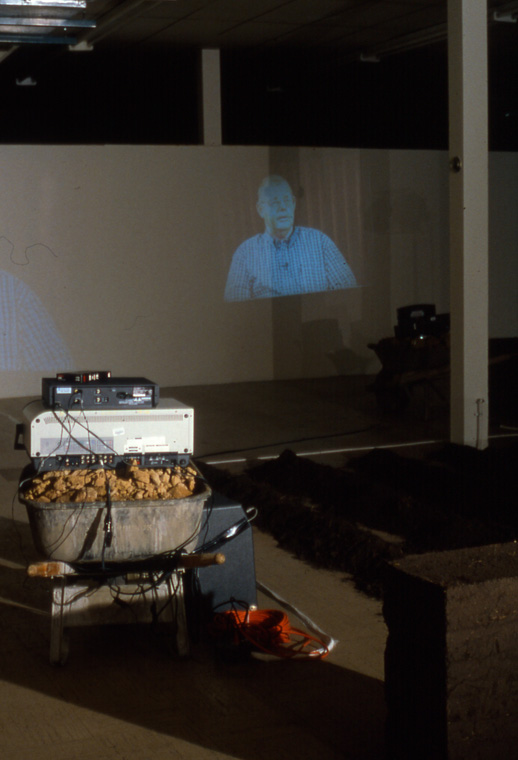Dekalb Farmland Project: and You Must Always Begin From the Ground and Conversations About Deklab
Installation with video, 2001-2002
DEKALB FARMLAND PROJECT: Installation with video
AND YOU MUST ALWAYS BEGIN FROM THE GROUND...(a line from Gunnar Ekelof's poem Ex Ponto), the installation, was paired with the video projection, CONVERSATIONS ABOUT DEKALB under the umbrella of THE DEKALB FARMLAND PROJECT, 2002, an unused 2000 sq' storefront (formerly a Woolworth's Store), rows of earth furrows 65' L and rammed earth solids ranging in size from 1' to 2' cubes, walls stained with local subsoil and topsoil colors, wall texts derived from sources that varied from local farmers to writers such as Aldo Leopold, Rachel Carson, Janine Benyrus and Angus Wright,. The "research wall" was made in collaboration with Northern Illinois University Soil Scientist, Mike Konen. It included resource books, soil core samples, soil color samples, comparative soils from prairie and agricultural sites, a photograph of the 6' deep soil pit from which the wall pigments were dug and an open copy of the Munsel Soil Color Charts text. In the back of the space the two video projectors were placed on wheelbarrows of earth with the double projection of CONVERSATIONS ABOUT DEKALB, 1 hour loop.
The project took place in DeKalb County, Illinois, home to some of the richest farmland in the world. DeKalb was viewed as a microcosm for issues of national and international, relevance: food production (agriculture) as it relates to culture. The project focused on issues of the financial sustainability of farmers and farming communities; environmental sustainability given currently prevailing farming practices; and development (urban sprawl) due to population increase which invades the agrarian countryside. As an artist working with social issues I chose to focus on the earth itself, soil, as a starting point. Soil is the matrix in which (most) food is produced and the substance consumed by development.
The project was sponsored by the Northern Illinois University, Art Museum, Museum Without Walls Project and received support from The Illinois Arts Council, A State Agency.
Complete text for the writing on the walls:
"And you must always begin from the ground,
again and again you must begin from the ground..."
,from Gunnar Ekelof's poem Ex Ponto
We're up against a worldview that nature is to be subdued. Angus Wright
The more we can imbue ourselves with amazement at the wonders of this universe, the less disposed we will be to destroy it. Rachael Carson
The landscape of any farm is the owner's portrait of himself. Aldo Leopold
It is the individual farmer who must weave the greater part of the rug upon which we all must stand. Aldo Leopold
From Biomimicry, Janine M. Benyus
Farmers are responsible for protecting their crops from things they cannot control.
Each time we plow, we simplify the soil, taking away some of its capacity to grow crops.
Does the soil smell dark and fecund as it should, like death and life commingled?
Over a mere century of tilling the prairie soils of North America, we have lost one third of their topsoil, and up to 50% of our original fertility. Jon Piper, Farming in Nature's Image
Since 1945, pesticide use has risen 3,300 percent, but overall crop loss to pests has not gone down...with 2.2 billion pounds of pesticides annually, crop losses have increased 20%.
[Imagine], an agriculture that will save soil from being lost or poisoned while promoting a community life at once prosperous and enduring.
How do you spring the mind free from its fears?
Farming in Nature's Image, Jon Piper,
“Over a mere century of tilling the prairie soils of North America, we have lost one third of their topsoil, and up to 50% of our original fertility.
[Imagine an agriculture] that no one can immediately cash in on. When seed companies or chemical companies see a cropping system that needs no seeds or chemicals, they're more likely to fight it than join it." Jon Piper
Are there any perennial grains?
Can a perennial produce as much seed as an annual crop?
Can polyculture yields stay even with or actually overyield those of monocultures?
Can the polyculture defend itself against insects, pests and weeds?
Can polyculture sponsor its own nitrogen fertility?
[Imagine] a domestic plant community that behaves like a prairie, but is predictable enough in terms of seed yield, to be feasible for agriculture.
Jon Piper, speaking at The Land Institute, Salina, Kansas
Where are our values? Now that atrazine has turned up in the wells of some farm families, 2, 4-D has been linked with non-Hodgkin's lymphoma in farmers, and Alachlor, the most heavily used herbicide on corn, is suspected to be a carcinogen, why are land-grant universities doing research to find crops that can be grown in the presence of stronger doses of it?
Gary Comstock, philosopher, Iowa State University
From Fatal Harvest: The Tragedy of Industrial Agriculture, Doug Tompkins, Andrew Kimbell, Editors
A modern supermarket produce aisle presents the perfect illusion of food safety...According to the FDA, at least 53 pesticides classified as carcinogenic are presently applied in massive amounts to our major food crops.
Since 1989, overall pesticide use has risen by about 8% or 60 million pounds. The use of pesticides that leaves residues on food has increased even more.
The Environmental Protection Agency reports that more than one million Americans drink water laced with pesticide runoff from industrial farms.
...in 1998, the FDA found pesticide residues in over 35% of the food tested.
...current standards for pesticides in food do not yet include specific protections for fetuses, infants or young children, despite major changes to pesticide laws in 1996 requiring such reforms.
A National Cancer Institute study found that farmers who used industrial herbicides were six times more likely than non-farmers to develop non-Hodgkins lymphoma, a type of cancer. Tompkins and Kimbell.
It turns out that food production that is safe for the environment, humane to animals, and based in community and independence is also a food supply that is safe and nutritious for humans.
To be sustainable, agriculture must be organized economically and financially so that those who use the land will benefit from using it well and so that society will hold them accountable for their failure to do so. Marty Strange, Center for Rural Affairs.
...we have been too timid and too anxious for quick success, to tell the farmer the true magnitude of his obligations.
Aldo Leopold
---------------------------------------------------------------------------------------------------------------------
Every minute America is loosing 2 acres of farmland.
DeKalb County is within one of three areas in America most endangered by urban sprawl.
Between 1990-2000 DeKalb county lost 4,794 acres of prime farmland, an average of 1.3 acres of farmland lost everyday in the past decade.
98% of DeKalb County farmland is rated as prime-a unique combination of exemplary soils, topography, and climate.
59% of the growth and development on the planet is taking place on prime soils.
Why save farmland?
Food
Raw materials
Absorption of rainwater-replenishment of groundwater and flood reduction.
Wildlife habitat.
Biomass for renewable energy
Enhances quality and biological integrity of natural areas
Provides open space
Improves quality of life
Jobs
